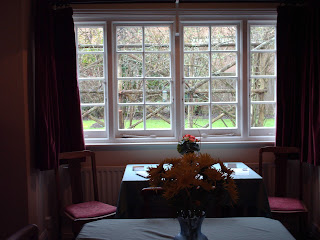Today, with my weekend visitor Kitty, I journeyed by bus to the suburb of Risinghurst, just to the east of Oxford. It's a modern, but appealing, neighborhood of two-story brick duplexes – somehow more homey and real to me than the grand ivy-covered mansions of Oxford. There, tucked down a picturesque lane called Lewis Close, is an older house, built from local brick in the 1920s. It's surrounded by a garden not yet in bloom. This house, “The Kilns,” was the home of the author C.S. Lewis from 1930 until his death in 1963. It's called The Kilns because it was located next to an old brickworks (that made the bricks for the house). Unfortunately the brickworks and its kilns are no longer standing.
The Kilns only does tours by appointment. Luckily we were able to schedule one. It turned out that there was a large number of participants on this tour, including a group of students from Concordia College in Minnesota, some Irish students, an art history student from Stanford and us (me and Kitty).
I have to admit I know nothing of C.S. Lewis. I was too old for Narnia when it first came out. I also never read any of Lewis’s theological writings. Basically, I was just curious – and Kitty was very eager to take this tour.
And it was a good one – full of details about Lewis and the others who lived in the house. Turns out Lewis shared the house with his soldier buddy’s mother and sister. He and his friend had vowed that they would take care of the other’s mother if one was killed in WWI; the friend didn’t make it home. Lewis’s American wife Joy also lived in the house. However she died 4 years after they were married. Then there was Lewis’s brother Warren (Warnie?) who lived there too. A full house. The guide told us many interesting stories about these folks, including the fact that the Lewis brothers were very messy and that C.S. went for a swim every morning in the little pond behind the house. There was also the rumor that he and his friend’s mother (27 years Lewis's senior) had a thing going on. (The guide didn't tell us this; it was something I read).
Anyway, here are some pictures I took at the Kilns – before my batteries died (again). After the tour Kitty and I walked over to the church that Lewis and his brother attended and where he is buried.
Anyway, here are some pictures I took at the Kilns – before my batteries died (again). After the tour Kitty and I walked over to the church that Lewis and his brother attended and where he is buried.
I might have to read Narnia…
 |
| The Kilns -- back of house. |
 |
| Dining room of the Kilns |
 |
| Room that C.S. Lewis wrote in. |
 |
| Needlepoint "kneelers" in Holy Trinity, where Lewis attended church. |
 |
| Graveyard at Holy Trinity Church where C.S. Lewis is buried. |
 |
| A grave at churchyard with snowdrops in bloom. |











